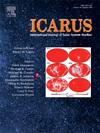Simulating the evolution of brine-saturated regolith on Mars
IF 2.5
2区 物理与天体物理
Q2 ASTRONOMY & ASTROPHYSICS
引用次数: 0
Abstract
We investigate the sublimation behaviour of brine-saturated Martian analogue materials in laboratory experiments and how compositional variations affect the development of the sample surfaces and subsurfaces. As a regolith analogue for our experiments, we used granular Saddleback basalt with the three grain size distributions 212–500 m, 212–2000 m, and 1000–2000 m. Our brine was composed of ferric sulphate, magnesium sulphate, and magnesium chloride. The samples were placed in a environmental chamber and exposed to a temperature of 243 K and a CO2 atmosphere of 5 mbar for several days. The samples were then insolated at 590 W m−2 with a solar simulator, representing the insolation rate at Mars whilst changes in surface morphology were monitored in vertical and lateral directions by two cameras. No explicit salt efflorescence could be produced on the surface. However, we found a stratification characterised by four layers developed within the samples. Beneath (i) a solidified crust at the surface, (ii) a dry, unconsolidated layer formed, partially characterised by white magnesium salt precipitates. A (iii) third layer was characterised by yellowish hydrated ferric sulphate precipitates, which filled considerable parts of the pore space between the regolith analogue grains. The (iv) fourth layer still contained water in the form of ice crystals and moisture. The spectral and mechanical properties of the sample surfaces were analysed after the sublimation experiment using reflectance spectroscopy in the visual and near/mid-infrared spectral range and cone penetration testing. The spectral comparisons of the uppermost crust with the non-saline regolith analogue material displayed a distinct spectral blue slope, indicating the presence of hydrated ferric sulfates. The strength of the upper crusts varied from marginally consolidated to strongly cemented depending on grain size and salt content. Our observations indicate that extensive salt crusts on the Martian surface are less likely to have been formed by brines present in the subsurface. Due to high evaporation rates, significant amounts of dissolved salts already precipitated below the surface of Mars, potentially leading to the formation of underground duricrusts.
模拟火星上盐水饱和风化层的演化
我们在实验室实验中研究了盐水饱和火星模拟材料的升华行为,以及成分变化如何影响样品表面和亚表面的发展。本文采用粒径为212-500 μm、212-2000 μm和1000-2000 μm的马鞍山玄武岩作为模拟风化层。我们的卤水是由硫酸铁、硫酸镁和氯化镁组成的。样品被放置在环境室中,暴露在243k的温度和5mbar的CO2气氛中数天。然后用太阳模拟器对样品进行590 W m−2的日晒,这代表了火星上的日晒率,同时用两台摄像机在垂直和横向方向上监测表面形态的变化。表面没有明显的盐开花现象。然而,我们发现了一种分层,其特征是在样品中发育了四层。在(i)表面凝固的地壳下面,(ii)形成了一个干燥的松散层,部分特征是白色镁盐沉淀。A (iii)第三层的特征是淡黄色水合硫酸铁沉淀,它填充了风化层模拟颗粒之间相当大的孔隙空间。第四层仍然以冰晶和湿气的形式含有水。通过可见光、近红外/中红外光谱范围的反射光谱和锥突穿透测试,分析了升华实验后样品表面的光谱和力学性能。最上层地壳与非含盐风化层类似物质的光谱比较显示出明显的蓝色斜率,表明水合硫酸铁的存在。根据颗粒大小和含盐量的不同,上地壳的强度从轻微胶结到强烈胶结不等。我们的观察表明,火星表面广泛的盐壳不太可能是由地下存在的盐水形成的。由于高蒸发率,大量的溶解盐已经沉淀在火星表面以下,可能导致地下硬壳的形成。
本文章由计算机程序翻译,如有差异,请以英文原文为准。
求助全文
约1分钟内获得全文
求助全文
来源期刊

Icarus
地学天文-天文与天体物理
CiteScore
6.30
自引率
18.80%
发文量
356
审稿时长
2-4 weeks
期刊介绍:
Icarus is devoted to the publication of original contributions in the field of Solar System studies. Manuscripts reporting the results of new research - observational, experimental, or theoretical - concerning the astronomy, geology, meteorology, physics, chemistry, biology, and other scientific aspects of our Solar System or extrasolar systems are welcome. The journal generally does not publish papers devoted exclusively to the Sun, the Earth, celestial mechanics, meteoritics, or astrophysics. Icarus does not publish papers that provide "improved" versions of Bode''s law, or other numerical relations, without a sound physical basis. Icarus does not publish meeting announcements or general notices. Reviews, historical papers, and manuscripts describing spacecraft instrumentation may be considered, but only with prior approval of the editor. An entire issue of the journal is occasionally devoted to a single subject, usually arising from a conference on the same topic. The language of publication is English. American or British usage is accepted, but not a mixture of these.
 求助内容:
求助内容: 应助结果提醒方式:
应助结果提醒方式:


